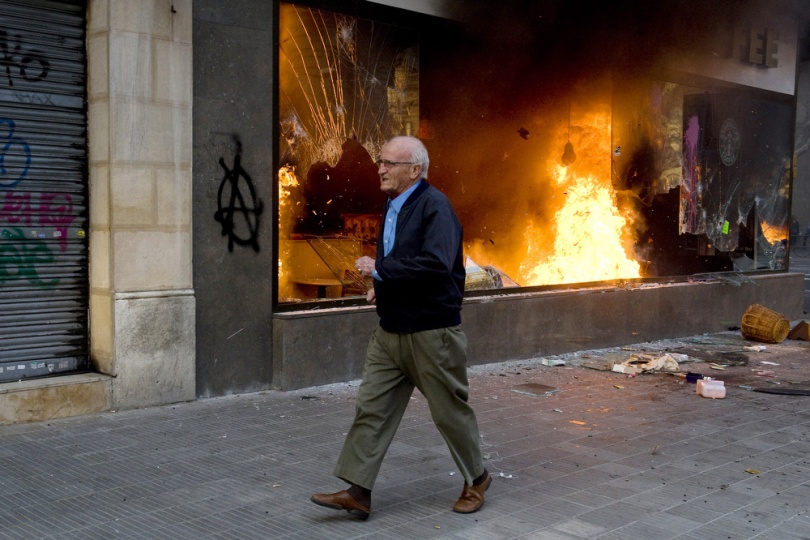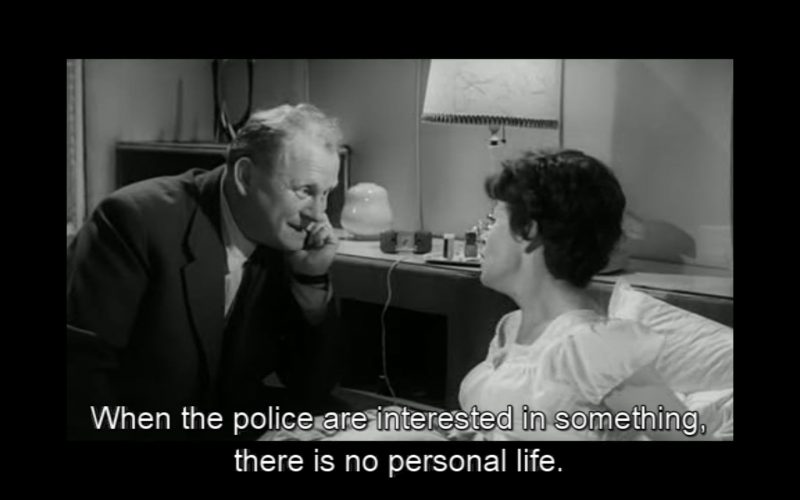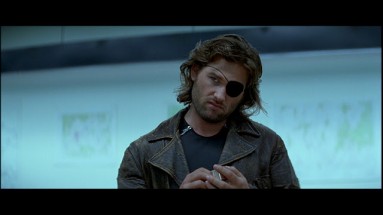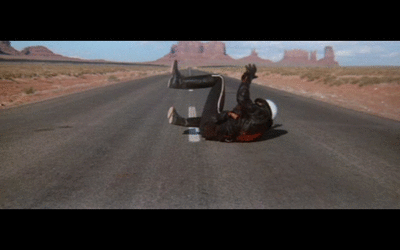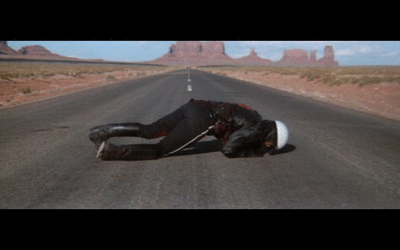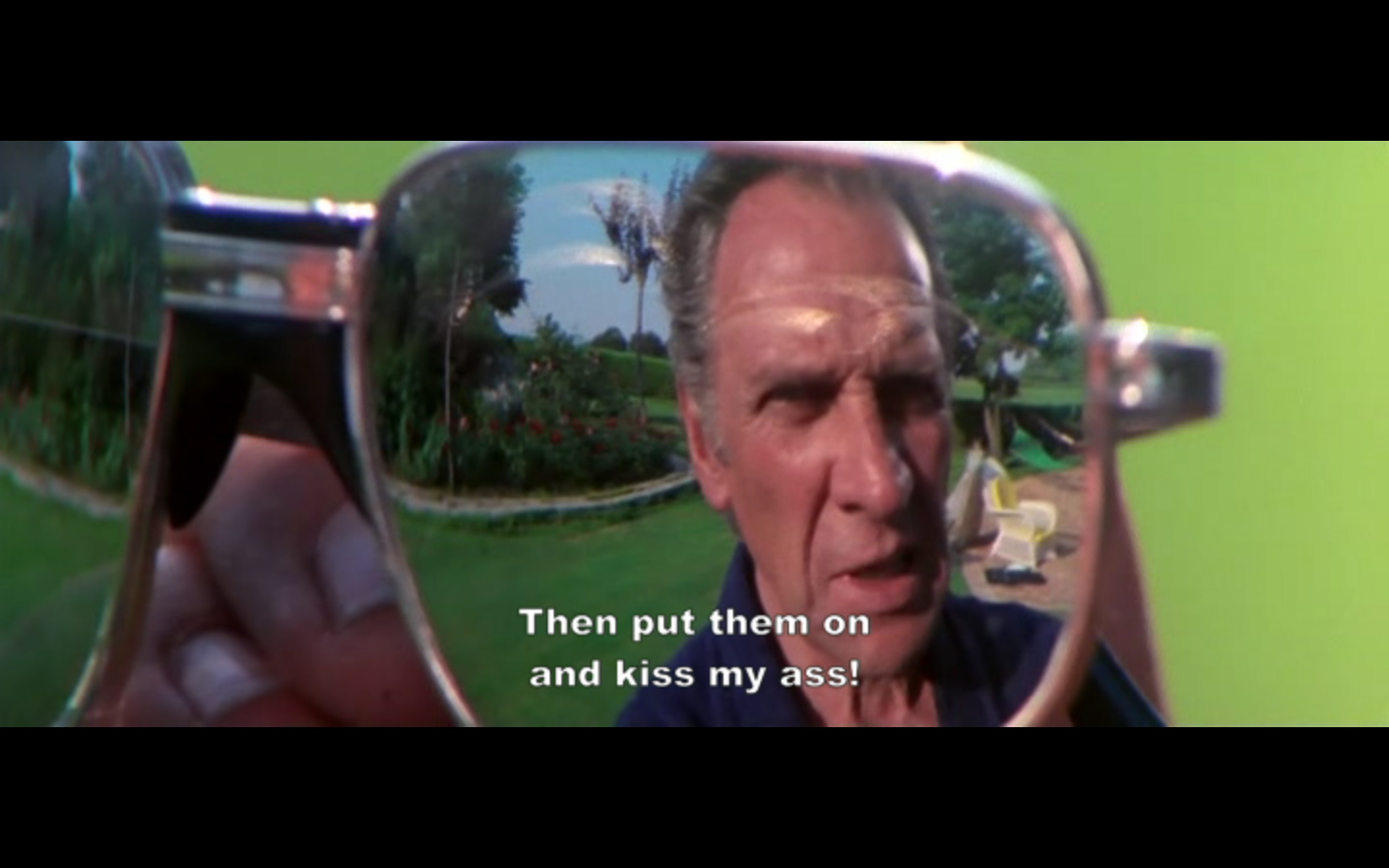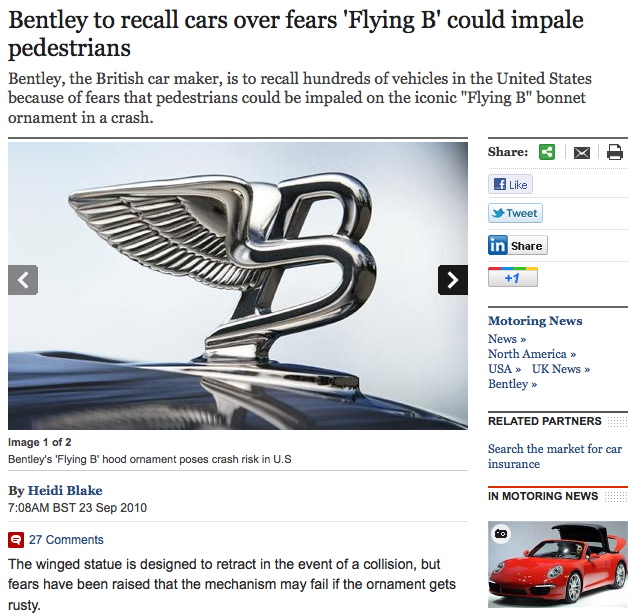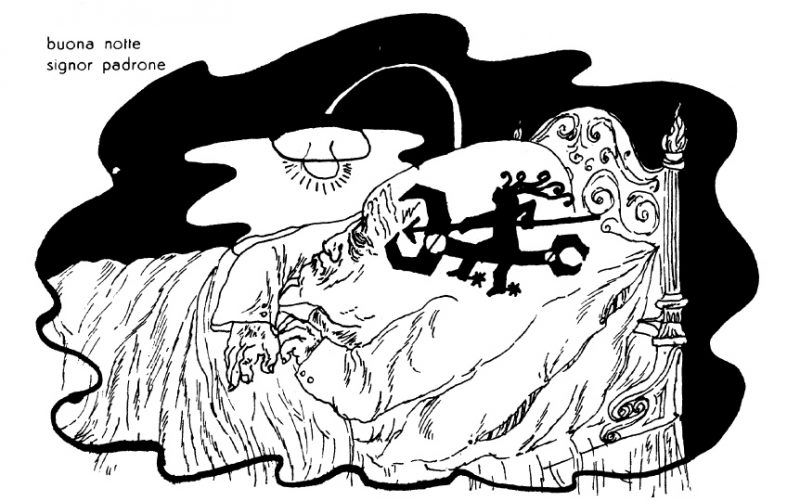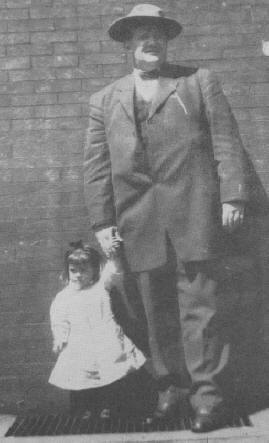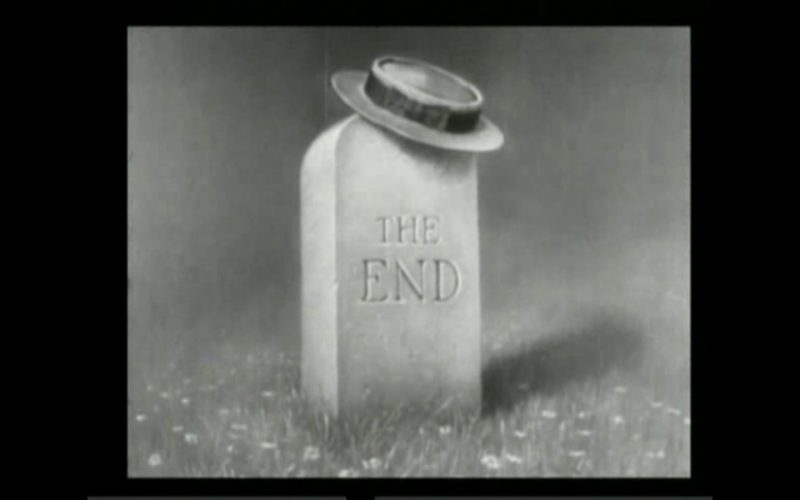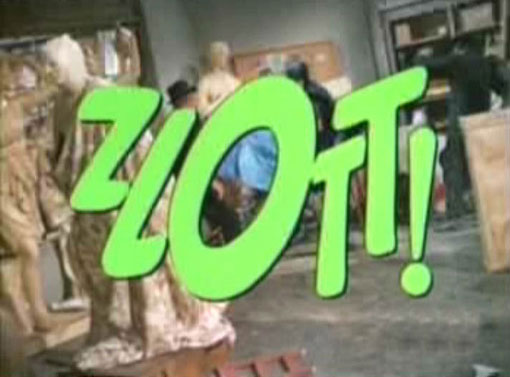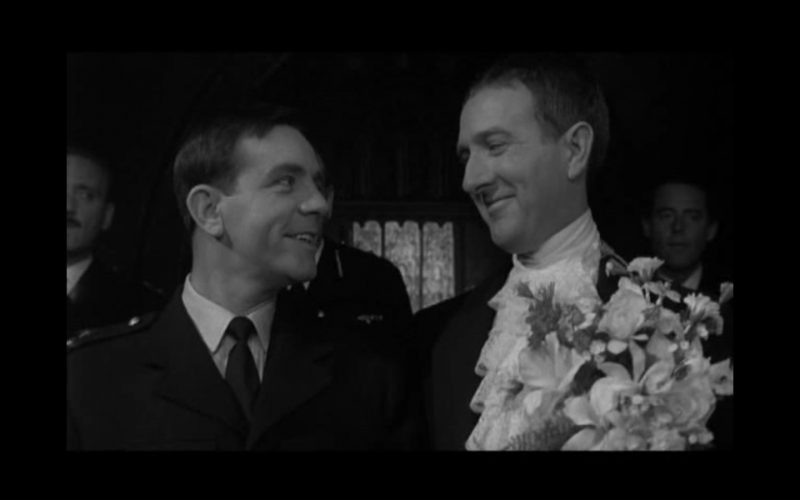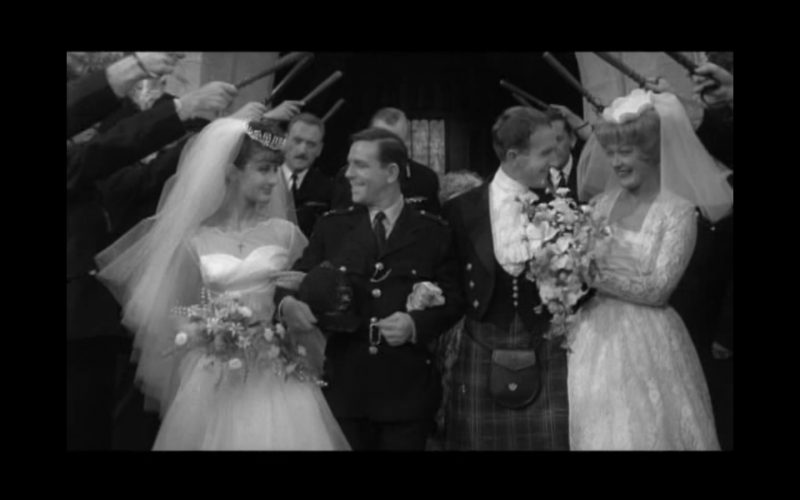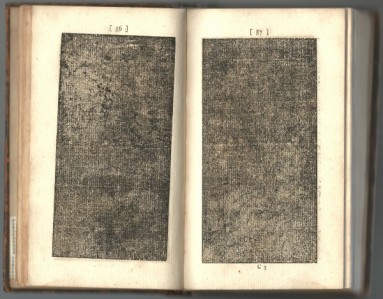BREAKING NEWS!
In Spain, the Angel of History moonwalked into the torched present.
Elsewhere:
He did exactly what they tell you to do.
Also, one wakes up to a screen that, when clicked, tells you how "Ces derniers ont fait usage de grenades lacrymogènes afin de forcer les barrages qui empêchaient l'accès au mont et ainsi disperser les manifestants. Ceux-ci ont répliqué par des jets de pierres." and, when unclicked, will remind you that, should you so desire to entirely forgo the realms of human sociability in the name of recycling, you can make a lovely hat from previously-used aluminum tinfoil.
The aluminum foil in which stones to be thrown come packaged, of course.
----
POINT OF DEPARTURE
“Biologists have prepared ‘red books’ of extinct or endangered species; ecologists have their ‘green books’ of threatened habitats. Perhaps we need our ‘black book’ of the places destroyed or nearly destroyed by human agencies."‡
COUNTERPOINT OF DEPARTURE
How ridiculous. We already have such a book. It is called the metropolis. It's not the easiest read, but it picks up near the end.
- - - - - - - - - -
A LIGHT PRELUDE
A cop walks into a bar. The bar is arrested for assaulting an officer.
http://www.youtube.com/watch?v=1KBlAFndg1U
NOTES ON COAL AND COLLISIONS. ALSO, AN INITIAL PASS AT ORNAMENT THROUGH THE FIGURE OF A HOOD ORNAMENT SHOVED THROUGH THE CHEST OF ONE WHO LIKELY CANNOT AFFORD THE MURDER WEAPON
Snake‡
plopped down the stairs like a coal miner, as good old Mr. Gooddeath would have done, letting himself be meat and gravity all together for once. Those heaving bellow lungs well open and of course they will be filled because that’s the point of being a miner, it has squat to do with these hefty chunks of worth borne upwards like grace for another man and then you get bought out by the hours for that, no, hell, it has to do with how much you can smuggle out. It’s dark as ape shit in there obviously but still you cannot be too careful because they have eyes for matter and gait, and when they sense you trotting along like someone wounded you in your colon because you have lodged a not insubstantial chunk of black rock in your ass, they’ll nab you for that, they will make all sort of vile insinuations about whether or not it was “economically motivated” or if you’ve been long looking for the chance to do a bit of plugging, gonna squeeze that into a diamond are you? you rump ranger, you little prince of the dropped shaft I bet you know where the canary’s gone missing to, snuffed out in your cavernous rear he was, but they don’t get it anyway and they can’t. Because it isn’t borrowed value or a cram of the perverse, it is precisely the two together, twinned up burrowing rods with teeth, and there is not staff between them cause we are not doctors and it has been stolen, in fact we stole it ourselves, for that is the real reason itself, to have thefted, because, well, because work is hell and because we also do not know how to be otherwise and those who say we should be are doctors and cowards. Yet you can’t put big pieces of black in your holes, no matter how many you got, or even cut the flesh to make a pocket and put it there, though one guy shoved tiny chips of the dark stuff under the skin, he opened himself up with a baby knife but did it right slow, less a cut than an unstitching of the dermis, he put the stuff under there, a mosaic to be invisible, for he opened the skin in a spidering line and slipped the chips under, from back of the hand to the crook of elbow up to his crook’s neck, only one a day, the coal’s carbon fang shearing free the fat, over months until it looked as if he had naught but a slightly bulging grey vein too many. And he got away with it too, crafty cock, until he nicked his ankle with a spade on accident and when the blood got loose, as you have anticipated reader, out seeped a terrifically black hue, and as he was a humanist he simply couldn’t allow for that sort of substantial miscegenation and he turned in his thief’s card to the altar of rogues. It’s blood in blood out, so we gutted him wide, he whimpered once, we waited for his nightish leak to harden again, and then we stole that too. And we don’t quit because we cannot and because we know that value is not a thing but a dust that gets in your pores, in your mouth, in your lungs, in the blood, you choke it or it chokes you.And so we rob the company blind by breathing deep while mining coal. We bring home pounds and pounds of the stuff in our chests, using our cilia as pipe-cleaners to hang the precious dust on and packing it against the lung walls, we smoke some butts to aid the process and excuse the cough so they don’t suspect, the huffed tar muddles with the coal into a sheening slurry that snaps into shape, diamond black walls of respiration. We crumble when we breathe but who could wish to be otherwise. Not us, not us who carry it away by the lungful, day in, night out, not us who come to our living rooms and hack and cough, who spit lightless on our floors and spittoons, all together on the holidays, expectorate brigands, crippled phlegming knaves of labor, we get together and we call up the past crusted and wet within us and we howl it onto into a sticky mass mess we call the fruits of work until it reaches the ceiling and still we do not stop.
We build a stolen stolen fire piece by piece. We drop a match.
They went down the aristocratic streets crying for death...We had reached the point of wishing for the death of a rich man. ‡
On civility [as politeness, that side-effect of the buffing function of Liberty's not being restrained and hence ready to put a real nice chrome sheen on the Understanding. Which, by the way, implies that the act of trying to understand each other and, God forbid, communicate is equivalent to facing off in mirror shades‡
]:
“We polish one another,
and rub off
our corners
and rough sides
by a sort of
amicable collision.”‡
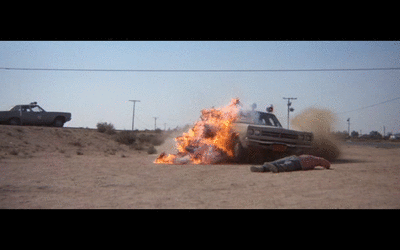 First they destroy your ride, then they rub you out - amicably - with the polishing flames they make of it.
First they destroy your ride, then they rub you out - amicably - with the polishing flames they make of it.
The Amicable Collision is unpredictable, see. Sometimes they rub too hard, taking off not the sharp edges, but the soft middle too. Thank God, there is commerce. It allows for the systematic deployment of collisions in line with an order that exceeds any one driver or buffer. “It softens and polishes the manners of men. It unites them, by one of the strongest of all ties, the desire of supplying their mutual wants.”‡
Regardless of the weight (5,754 pounds) behind The Amicable Collision, what truly stings - what cuts you right through - is the tiny bit of ornament. For that ornament specifies, it reminds that such weight is no accident, not an oafish cheapness, but consequence of a second quantity (202,147) and a second meaning (£) of pounds.
First, they are run you over, then they insist on not polishing their ornament. Such is the ultimate sign of luxury: to have a $320,000 ornament, supported by a mass of ramming weight and speed, and to let it get rusty. It is the height of The Amicable Collision, its supreme drive, not content with a bit of spit and polish, not happy just working the edges. It wants to get to the guts of the matter, by means of letting ornament - superficial modulation - lead the way, refuse to tuck itself back into the thing itself when times get bad.
Such will make people nervous. They will spend centuries trying to reign ornament in, trying to insist that if it is allowed, it will stay in its place, stay around the edges, a tendril or arabesque here, a few repeating lines, but never the two together. And if it is allowed front and center, it is so only on the condition that it can be put away.
http://youtu.be/zFaZY28Z2VY
--------
WHOSE BLOOD THE CAMERA FOLLOWED AND FOLLOWS STILL
http://youtu.be/Gkz7Mv8DF_8?t=9m4s
[watch from 9'04"; then watch the entire video]
It is often said that cinema is dead.
Or dying, or deserves to be. Or that it doesn't deserve to be, so its twilight is sad, but hell, it had a good run, so it goes. That, given the quadruple salvo of television, the internet, video games, and the general worsening of the public sphere, that diffuse, heterogeneous, and sprawling thing called the cinema - and the act of going to it - has been long on the way out.
Or, at the very least, that it is in crisis, and it will mutate, splitting itself into even further irreconcilable tendencies. A fair speculation might include the following: big-budget films learning to directly probe and provoke neurological response (in a dark mirror of Eisenstein's dream of montage that could produce direct and measurable physiological effects); smaller-budget pseudo-independent films aping that tendency, at least in the look and rhythm of it, to prove that you can do it on your own and therefore strengthening the aesthetic dominance of the very thing they pettily claim to critique; old-fashioned prestige films drawing on twinkling nostalgia for the long far-gone (already in play from fake grindhouse films through The Artist, Super 8, and et-bloody-cetera; just wait for the early '90s nostalgic reload, in which the look and lingo of Hackers is meticulously recreated); a proliferation of genuinely oddball cheap things, that look good and cut strangely in a way that can't be reduced to an object lesson in imitation; ever-increasing archives of documentary material captured on cell phones during riots or outside apartment blocks during police raids and made available by necessary groups like Mosireen to be put to the best possible use; national cinemas that have never particularly aligned with the style, patterns, or concerns of Hollywood narrative and hence follow their own tracks, producing material that will be retroactively cannibalized (primarily in remakes) by the industrial film centers with enough profits to weather the coming decades of financial entropy; and, above all, a endlessly unfurling swath of more of the same old shit.
Or, most plainly, that the essence imagined and called the cinema has died without coming to terms with this fact or, conversely, convinced itself of this death without it being so, such that all the same a pallor and rot, real or imagined, hangs over it, even as it goes about making a killing, making shit, or both. That it proceeds in a manner too Cotard, not enough Coutard.
All that may well be, hyperbole aside. And of course, similar things have been said many times throughout the history of what has been said about cinema.‡
Despite the recurrent frenzy of such attempts, however, it has never made much sense to to speak of the cinema as capable of being alive or dead. Because to do so reinforces the idea that it had a central essence, a common "vocation" as some like to imagine it. And, more often than not, that central essence coagulates rather conveniently around a Hollywood axis, geographically in the global north, and conceptually, with mass spectacles on one side and less-mass, not-quite-spectacles on the other. I have, ultimately, very little invested in this debate about vocation or essence, for the reasons above and because it shoves to the side most of what has been interesting to watch, laugh with, jeer at, and talk about.
Nevertheless, perhaps this death is true. But its truth or falsity doesn't explain what is relevant in this instance, the one in Four Days of Death in December: the fact that here, 9'36" in, a full century after the start of the film industry as a spreading global phenomenon, a technique - the tracking shot - has found the usage it has demanded all along. That is, the cinema may be dead, but that death means only the disembedding of its techniques from any supposed essence and the scattering of its operations out. Its capacities remain to be, and are, picked up and carried to potentially better use. The tracking shot, moving not on rails or Steadicam but in a hand along the trail of the blood of protesters, here makes sense. In three senses: it alone makes sense of that physical duration of a brutalized body, a duration that becomes clear insofar as it is not in a body but spilled and smeared out across the ground; it produces sense afar out of the too-easily abstracted fact of bloody and desperate struggle; and it makes sense of a technique, a formal operation. It makes sense of the last by raising to a bristling pitch the unsupportable gap between the seeming neutrality of a technique and the fact - that blood - that it records, elaborates, and by which it is transformed.
Like the machinery and material of capital, techniques are not, and never have been, neutral.‡
Such was the point of what I tried to unpack elsewhere about salvage and sabotage. The innate, obscure, and tremendously specific hostility of things - a hostility that grows from the general fact of an entire social order, but which shows itself in quite particular arrangements of sharpness, toxicity, rigidity, bacteria, and capacity to rot - emerges only when they stop working as they were meant to and begin to stumble, or are willfully taken up, into an arrangement and usage that lets that hostility and different utility roar into view. Crucially, in this project, I want to stress that not merely as a fact of objects or situations (whether they be cars, books, or political scenarios) but also of techniques, styles, moves. They too carry within them a tremendous and highly material set of echoes, histories, and determinations. Rarely, ever so rarely, this saturation bears itself out into the open. More frequently, that is the needed practice of critique, to bring them forth: never to apply a predetermined theory (whether that be Marxist, Lacanian, post-colonial, queer, feminist, old-school close reading, and so forth) that seems fitting or for which one already has a predilection or commitment, but to begin with the inconsistencies and shadows of a local instance. And then to let those double back onto whatever approach has for a long time been worrying away at that rat's nest of contradictions. (To do so has the added benefits of a decently open starting ground, namely, the thing in discussion and the openings it provides, rather than a potentially hermetic set of references.)
It has always struck me as a silly endeavor to speak of anything as being the "best" of a category, tempting as it may be (and as often as I've done so). Forget the best. What can be said is that this technique, this instance of camera motion and death's stain, is adequate, in the real sense of that word, in that it demolishes a gap between a form that could be used for a number of instances and a material instance. It is adequate precisely insofar as it isn't ok or functional, but by means of making these things - a shot that tracks, a track of blood, tracks of stones that mark that blood, a camera that records that motion, an unnamed body moving it - briefly equal and inseparable. It is for this reason that the tracking shot finds what it has always demanded here: a moment of raw, unsupportable correlation that collapses together the desperate material with a cinematic technique so that they cannot be told apart. The blood can't be shown without the technique, but its duration and horror binds to that shot and shows that it was, in some subterranean way, made for this, no matter what other instances it has articulated. What matters about this, however, isn't that it somehow makes those other instances (dancefloors, serial killers, parties, streets) irrelevant, that it condemns them to the realm of "art" while this belongs to the realm of "life."‡
It's there, in that "not working," in that sick overdetermination, that critique can start to find a footing and, rarely, do something worth doing with what it wants to foreground or have done with. As such, what follows in my writing here will try, sloppily, to hold close to the two relevant tendencies at hand, two kinds of instances:
to what necessitates the form in which it happens (i.e. in the video above, the showing of the horrific physical duration of that bled-out body requires a shot that lasts and moves as this one does)
to what imposes its form on material, consequences be damned or strange (i.e. the sense that films, books, paintings, etc, are not a set of decisions about how best to portray what has been selected as an interesting/fun/subversive/etc subject matter, but that the urging of the how is there from the start, dictating - for better and often for worse - what might get itself portrayed. On the worse, see the general shoving of all narrative into roughly acceptable domains of focus [the story stays on track] and "believeable" [mediocre] characterization. On the better, see those discordant instances, such as the start of Hammer's 1958 Dracula, in which the yearning for a roaming camera and a certain tint of red leads to an entirely unexplainable splattering of cadmium paint, with no narrative source, body, or murder, just a bare pointing and mess)
Above all, to what pertains between these two. If one wants to talk not just about cinema but about cultural production in general, not as a zone separate from "life" but as an inextricable part and modulation of this tepid hell in which we live, then these two lines and the space they demarcate, like those stones and that blood, seem a crucial place to start.
And, whenever possible, to start not from those things in general, but from singular points: that tracking shot, those stones, that blood. That ongoing war. And given the last, the only other relevant point of beginning, given what is happening now, again, and still, is to say: courage and love to those fighting in Egypt still, infamy to those who kill them and to all those who support their killers, vengeance for those whose blood that camera followed and follows still.
IN WHICH A SET OF MATERIALS ON ITALIAN UGLINESS AND LABOR WAR-MAKING GATHERS A HEAD OF STEAM
One day God created Satan and told him, “Nobody is uglier than you.” One day there was a great famine in the world and Satan said to the Lord, “Have you seen, Master, that you are wrong: the famine is uglier than I am.” And God said, “You are right, this time you have won.‡
It's at once easy and difficult to speak of the family: in certain ways, we grasp it totally, we’ve already got it, or we're just about to nail it. It seems a thing totally quotidian, totally normal, that seems almost stupid to name in the midst of a political discourse. Because the family, our family, is a private thing, our personal problem, from which can arise conflicts with parents, with a wife, with a husband, with aunts, with our sons. But this is normal, "it's always been like that," and everyone resolves it by oneself. Unfortunately...
Outside the family, we live labor, the factory, the office, friends and comrades, politics, social problems, economic problems; inside the family we can shed our professional and social roles, we can show ourselves in a "human" mode, with our emotions, our anxieties, we can escape, we can do what we feel like, because it all stays "in the family." Now we take account of the fractures which lie beneath this scission of our life. And, therefore, we want to understand what is the real function that the family still has in relation to the complete exploitation to which we are subordinated day after day. We want to know what it is, who it serves…
The family, as a material and juridical institution, as ideology, is one of capital’s major agents for making the process of exploitation function. With this we don’t want to put in doubt the sincerity and the need that each of us has to express the affection, the love felt for one’s husband, for one’s wife and for one’s children, indeed.2 But exactly because we are, in general, constrained to satisfying our affective needs solely inside the family, it follows that we frequently no longer treat the persons closest to us with love.
Defining the family as “agent of capital,” as an institution that acts fully in the interests of the bourgeoisie, we refer above all to a series of functions the family carries out, which, taken together, are inseparable from both objective-economic and subjective-affective aspects: the acceptance of authority, of the social hierarchy that teaches us to breath the family like air (hence without even noticing it); the division of the world into public and political affairs and private and personal affairs; the lives of others not as autonomous persons, on the basis of how they express themselves, but rather always as persons with determined roles: they are children and therefore innocent, cretins, incapable; they are women and therefore weak, emotional and passive, they are men and therefore strong, active, aggressive, they are old and therefore senile, useless or ridiculous, etc; in short, the division of society into classes that the relation of authority and subordination in the family prepares us to accept, and the division of men into social roles that divides us further into men, women, children and the old within the same class.3 It’s for this reason that the political discourse on the family seems to us as revolutionary as that on the factory, it’s for this that the opposition between the “bourgeois family” to be abolished and the “socialist family” to be constructed, as posed in the tradition of the worker’s movement, is revisionist in the true sense of the word, in that it represents the penetration of bourgeois ideology into the proletarian.
1. ECONOMIC AND IDEOLOGICAL FUNCTION: PRODUCTION AND REPRODUCTION OF LABOR-POWER
If the family didn’t exist, they would have to invent it. Think about it a little, don’t just laugh… The world we know and capitalist society in its particular mode is characterized by the division of labor that, at the same, exactly because it’s capitalist, is a hierarchical division by age, sex, and social role…
The familial world, on its side, is characterized by the division of roles: the father who works and brings home the cash, the mother who cares for the kids, the kids who have to obey, the grandfather who is fundamentally superfluous, etc.
And this seems totally natural to us. Yet when we come to know the reality outside our families, as it happens, we find also there those dividing functions, by class, by sex, by age, by hierarchy, money, power, etc. And, very nearly, it again seems natural! And so, having learned the hierarchy of roles in the family, they easily have us believe that this division of labor was always there, that it must be in this mode, because, in fact “it was always like this.” Wasn’t it always true that “who doesn’t work doesn’t eat?” - that “the women’s place is in the home and with the kids?” - that “the man takes and holds the position of command and responsibility?”
These small examples reveal plenty just what the role is that the family ideologically conditions in all of us.
The principle function of the family is that of the production and reproduction of labor power, whether materially in regards to the birth and raising of children, the care and feeding of various family members who sell themselves on the labor market, or from the psychological/affective perspective, with regards to education, sexuality, affective needs. The familial organization furnishes capital, day after day, with workers regularly fed and dressed in a manner modest but decent, sexually satisfied but not too much, so as to not disturb the punctuality and rhythm of labor, organized and resigned in accord with the hierarchy of factory and beyond.
In sum: immediately integrated persons. And moreover, it assures the the continuity of all of this for future generations.
All this comes though a privatized mode, entrusted to women’s work, who reproduce labor power as mothers and housewives: a heavy labor, not salaried, socially unrecognized, and barely thanked. Commending this work to work who carry it out privately within the family, it satisfies various needs of capital:
- it can keep down the cost of labor-power: in fact, if the goods and services required for the reproduction of labor power can be provided at low cost thanks to the work of housewives, bosses can keep salaries relatively low.
- many needs satisfied privately in the family could be satisfied socially, but as of now, for various motives in line with the economic and ideological order, they serve to buttress the organization of the nuclear family, each with its own house, furnishings, appliances, toys for the kids. This organization permits, above all, keeping one half of the population (women) in a state of near welfare; moreover, socialization of these services would require major structural reforms.
Not just this. The little nuclear family, typical of advanced capitalism, composed of parents and children, became important as a nucleus of consumption. This has a double consequence: if we think of the exigency of industrial capital to produce and sell ever more products to realize its profits, we understand immediately the utility of this organization: every little nucleus buys and consumes its television, its washing machine, its toys, etc. Central for the ideology of consumption, which comes to present itself as a true and proper style of life, is the woman-housewife, who manages the salary of the head of the family. Advertising aims above all at her: the woman-housewife, deprived of any autonomy, deprived of salary, deprived of a creative job, routinely frustrated and annoyed, is to called to positively live out her subordination. The “right” choice of various products is suggested as her particular specialization; misery and limitation, absurdity and the repetitive fatigue, all the imbecility of domestic labor, as it is, is gilded as the vocation of woman. In this mode the existent family structure will be utilized and reinforced: the identity of the housewife based on her house, her washer, her television. But this isn’t just a problem for the housewife: along with her, all the components of the family receive a fundamental lesson in “private property” and, perhaps, we are all the more exploited, expropriated, proletarianized the more that we grasp onto those few things that are “ours.”
In this sense, the institution of the family, which for the bourgeoisie - and for none other - functions so as to materially hand down private property, functions in the subordinate classes to conserve the idea of private property. This aspect is fundamental, because a system, based on private property, can function to the degree which, in whatever mode, we who do not actually own anything still believe.
- The production of a certain type of labor power, adapted to the needs of capital, and also at the personal and subjective level. The necessary capital of efficient, assiduous workers who accept their exploitation without rebelling, who are punctual, ordered, egotistical, scabs, and interested in nothing other than their own interests. And also in these duties the family reveals its height: through the interiorization of the roles of familial relations, it succeeds in producing individuals who, even before entering the office or the factory, are conditioned and prepared for the subordinate social and laboring roles that await them.
II. RELATIONS BETWEEN PERSONS = EXCHANGE RELATIONS
If we start to consider the family in these terms, it isn’t just as a grouping of individual persons, but as a structure within which, in spite of us, we are all conditioned in a certain way and of which we have to take account, in which we find the same relations of production, described by Marx, as that of the entire capitalist society. There don’t exist only relations of class - “the man is the bourgeoisie, the woman is the proletariat,” as Engels said - but the same relations between people that become relations between things, between sellers.
… It’s really through values given in the family that we start to live the relations with others through the optic of exchange: “I give you this, but only if you give me something else in exchange.” “How much we did for you, and you don’t even give us this and that other” is a recurrent formula between parents and children. And in fact, the parent-child relation is always a relation of possession. The parent has the authority, the money, his force, his power of being adult to impose on the kid. The woman has the relation of material-affective exchange with her man, she lives inasmuch as her family needs her. In this mode we learn from a young age to ration our emotions and our affects like a cake, a piece here, a piece there, but make sure they repay it! All this isn’t devoid of violence, surely… the violence that is done, that we do to ourselves and to others is always the same violence we find outside our houses, in the class struggle, in the school, in the factory. In certain modes it appears even within our private sphere, at the house, in the family, where one would expect it less; we pack in a lot of violence that public life wouldn’t dare to make explicit; often it’s easier, it comes more naturally, to beat kids rather than to stand up to the boss…
III. AUTHORITY IS FAMILY
Bourgeois society, since its birth, bases itself on the formal liberty and equality of all individuals; it no longer uses immediate physical violence, constriction, slavery and people as private property as during feudalism. In sum, “all are free to sleep under the bridges.” But if immediate physical violence doesn’t exist as it did, in feudalism, for example, there are other things to make sure that individuals, that all of us, are kept in line, acting against our interests. Because it isn’t in my real interest to produce profits for the boss, it isn’t my interest to mistreat my family members, it isn’t my interest, in any case, to get myself treated badly by them and to accept it like a natural thing. But how did this happen? The explanation isn’t simple, because it touches on the mechanisms within our depths for which which the institution of the family had and still has an very important function: the acceptance of authority, the acceptance of social hierarchy and, in the final analysis, the acceptance of our subordination as something we want from ourselves… the young child who refuses dirtiness, whereas, with a bit of good sense, we know how they love puddles, the boys at school who pit themselves one against the other, and all against the girls, in an absurd competition to recite that material with which their real lives has so little to do… How come?
How does the family enter into all of this? It enters, all right. It constructs inside of us that type of consciousness that, at the right moment, tells us: you need to do, you need to obey, you need, above all, not to do… We all recognize in certain ways this internal voice that gives us instructions, that wins out when in truth we have little desire to do certain things. And where does it come from, if not from our parents? Once again: regardless of whether or not we are particularly naughty or repressed, they have, nevertheless and in general, directed us, forbade us, ordered and many times suffocated us with their “love.” Just as they learned from their families, with all the best intentions.
From the first years of life, the child picks up the principal norms and laws of the society in which we live and acts in accordance with them. The person who imposes on the child these roles is in some ways the father, the authority of the father that derives from the fact that it’s he, who within the family has the power and makes the money, is the “head of the family” [capo-famiglia]. The father is the person that has his identity outside the family, in work, in the public sphere and therefore it’s he, above all, who carries the laws of society into the family, it’s he who represents norms and authority. Identifying himself with the father, the kid identifies himself also with the laws and the norms he represents. The first times it needs to be imposed on the child: no, this is prohibited! Here, this needs to be done! (Albeit with some slaps, because the child is young and “doesn’t get it”) - after which, if the education succeeds, the child does what the father commands, without the further need of slaps and yelling, the child does things (and perhaps starts to impose them on other children) that he admittedly doesn’t understand, not knowing why he does them! Other things, other attitudes to be learned, are identified with the mother, now as before, the woman subordinated and pressed into service; this is a reality that doesn’t escape the child. Seeing his parents, the child perceives the subordination of the mother and therefore that of woman, so much so that the prohibitions and the orders of the mother become harder to take seriously…
Therefore the child doesn’t just interiorize and make his personality around laws and social norms, but also immediately interiorizes the entire hierarchy. Once the child self-identifies with the father, the parents, and hence with social norms and their hierarchy, once having perceived others on the basis of the functions and roles they play, the child will tend, in the future, to automatically reproduce the same mechanisms. Later in his life, faced with various figures of authority, he will meet: the professor, the commander, the judge or the law, the boss, the state, etc, and he will show a great susceptibility to them.
This process, within which we are “socialized” for our future functions in this society, is typically bourgeois, and the place where it all comes from, as well as its components, is the family. As such, to leave this struggle outside of a revolutionary strategy is serious. One more time, the class enemy is not only outside, in the factory, in the state, it has well and truly infiltrated inside of us. If we don’t understand this, we will never understand why it’s so difficult to make the revolution and we will know even less how to do it!
IV. WHY THE DIRTY LAUNDRY MUST BE WASHED IN THE HOUSE
The development of capitalism brought an ever-growing socialization of production and public life: the big factory, buildings, the group vacation, the mass media, the supermarket etc. At the same time, however, all of an important part of our life remains confined in a totally isolated, private environment: the family. This contradiction is not casual and is of no small importance. In fact, here too we have to deal with a fundamental contradiction of bourgeois society, fundamental because the whole system holds together to the degree that it perpetuates itself. And it perpetuates itself through the function of the law of profit. Public life, production and administration at the political, social, and state level comes to be rationally directed, with calculation and coldness in an impersonal manner. All the “individual” needs of people, bourgeois included, come to be confined in the private sphere, in the family. Classical puritanical ideology split man in two: the professional figure, political and public, who must function without oozing “human weakness”, and the human being with all his emotions, sexuality, and aggression. These two spheres came to be rigorously divided: public affairs were declared taboo in the family, such that the wife had to be kept far from the storm outside the house and the kids would not understand, but even more separated were personal problems, immediately identified with those of the family and excluded from leaking into, or taking part in, public life. “Dirty laundry” must be washed in the house.
This is the formulation given to the bourgeoisie - but we’re all victims of this. To reiterate, this doesn’t just concern ideology or good will; things de facto stay in this mode, for there remains practically no space outside of the family zone to satisfy certain needs. For those who refuse the norms, there are heavy sanctions: solitude, the fear of aging, isolation, insecurity, etc. Obviously the situation isn’t equal for all: the spaces of relative liberty vary according to class, and inside of this are the secondary conditions of sex, age, etc. To the extent that this increases the material constraints - economically, that is - persons are primarily constrained to relegate the satisfaction of their needs to the family sphere. With 8 hours of hard work, with the commute and other inconveniences such as irritation, exhaustion, and general discouragement, the dream easily becomes that of “peace” in the family; at least there you can hope to find what’s usually denied. And of course, what you rarely find will come to be seen as the exception to the rule.
It’s the basic acceptance of this separation between public and private, rational and irrational, political and private that will be attacked, not the individual who falls back on his family as a solution to his problems. For those needs are real, but the family is mistaken response to our needs.
The separation between public and private comes to be lived as SEX [all caps in the original], as the most “ours” of all our factors. And this false respect for the private serves to mask the incredibly heavy conditioning that accompanies every individual from birth and out of which emerges a real sexual “politics” which, while mutating into forms to adapt to the diverse needs of the bourgeoisie, nevertheless maintains constant characteristics.
The basic idea is that the pleasure principle is scandalously incompatible with the idea of performance and exchange.4 An individual dominated by the desire to get a taste of life and who refuses to quantify her/his needs is unpredictable, ungovernable, bizarre. Who succeeds, even amongst the most democratic, in imagining how one could be without feeling a dull resistance? It’s not for nothing that we have fear and shame for the imagination of our freedom. It [i.e. the social order of capital] needs reality to present itself as the impossibility of the pleasure principle, because reality is the most instructive of theories. It needs to find a secure place, reliable, able to carry to the end this project of sexual alienation without which it isn’t possible to reproduce on a large scale the psychological profile of the modern slave. This privileged place is the family. Because in the family sex becomes “licit” [lecito, i.e. permissible], and the pleasure principle takes that particularly distorted form of “the union of flesh and spirit” toward productive ends, it is therefore obviously limited to adults and heterosexual couples. And an adult is, in any case, one who has passed through the hands of a familial education. One who has been able to suck the maternal breast only as long as there was milk and who is yelled at for substituting the thumb because “it deforms the mouth,” one who cannot touch oneself, masturbate oneself, sniff oneself; one who will be progressively estranged from her own body to the point of disgust in shame at other flesh in general and who will experience the physical dimension with a profound sense of guilt. Someone who has to learn and distance oneself from her own objects of love and channel her sexual instincts into the assumption of a role. Someone who, if a man, must mutilate, violate, and destroy his emotions and all that might trigger them; and, if a woman, must represent the very symbol of this mutilation, become flesh, prey, temptation, the impossibility of autonomy because of being the maximum function of the autonomy of others.
Every adult at last finds that he has been granted his sexual role, when the disaster is already consummated.5 He reaches that point already apprehensive, with a profound sense of guilt and inadequacy and with a boundless greed that renders him envious of every pleasure, jealous and possessive. He’s therefore ready to hide himself, to normalize himself, and to normalize his children and all others, such as adolescents, who aren’t already ready. And he will educate them as they must be educated, so that they must even as a child be able to see the enormity of their own alienation. But the relatively privileged bearer of the model of sexuality imposed by the system isn’t identical to the norm that he knows he must “present.” As such, a critique of the family that puts individuals with their needs on one side and capital on the other is a critique that, while striking at the sign has a short breath. The family isn’t “one side”, it’s in fact “one side” with that particular violence that bears the power of one sex over another. Because already today the sexual oppression of woman is sanctified within the double work6 and within the family. Because in that particular form of the renunciation, entirely female, of the possession of one’s own body, is born the passivity, submission, the not-knowing how to think for oneself, and that romantic vocation of the servitude of a man that in good faith passes for “Love.”
Paradoxically, the woman so desexualized and violated enters into a contact with reality, through her sex, with her being woman that conditions her step by step. In this society, the woman is always and everywhere a sexual object; it’s with respect to her sexual utility that she comes to be qualified (the “old” woman for example is valued least of all). And her “beauty”, that thing so perishable and subjective, comes to be qualified and reduced to merely a measure of her social acceptability.
The woman remains object to the degree in which every autonomous expression of her sexuality is impeded. So the ideal is to always see her as the possibility, entirely without danger, that she will get “fucked,” “screwed,” and “laid.” And then redeemed through the benevolent love of a man who puts himself low for her, and for her alone, through marriage, to consider her his equal, to insert her in the “world,” just as his father did before, in exchange, naturally, for a sum of services rendered with love and therefore, obviously, unpaid.
That's why the family, the couple who is presented as a unit must be seen as having distinct parts. We must continually discern the opposition and impossible unity between, on one side, the woman, sexually deformed in the way we know, who symbolizes the recomposition of the entire emotional sphere for the man, and, on the other side, the man, reduced to that which is known in capitalist production, who must recompose the whole social and political sphere for the woman. So desires the ideology of the union of marriage - the ugly reality of which we all know a little. The ideology of the “naturalness” of this state of affairs is hard to attack, all the more so because the fact of procreation - the fact that there are good and bad women who have children - is a natural given, on which they easily construct a reactionary discourse. Given their “objective” roles as housewives and mothers, given secular sexual oppression, given the state of ignorance in which they are kept with violence, women were, at first and frequently, conservative and reactionary. But this is also the other side of the coin: precisely for the reason that they are at the center of the whole family order, precisely for the reason that they are the “weakest link,” precisely because the various forms of oppression - the oppression of class, sex, and age - are all supported by their role, it is them, it is women, above all, who have an objective interest in ruining this condition.
Study Group on the Family
In Collaboration with the Workers’ Committee
ALFA-FACE-IBM
from “Rosso. Journal within the movement.” May 1974, n. 10
1 The title in Italian is “Ma che cos'è la famiglia”, which literally means “But what is the family.” However, the expression “Ma che cos'è...” carries the sense of exasperated confusion, a “what the hell is this thing?” Hence, the liberty taken in translating it as such.
2 In Italian, the gendering of the possessive depends on the gender of the possessed object, not of the possessing subject: hence in the original, even if it is assumed that it is her husband, his wife, it technically remains grammatically neutral. Throughout the text, I’ve tried to use “one’s” in place of his or hers where explicable, except for instances in which a) the subjective formation being described is particularly male or female or b) when the prose would be made too awkward by a constant use of “one's”, in which case I use “hers” as the general.
3 This is an odd moment in the text, as the word uomini is used here to describe both the division of “men” into social roles and one of the social roles into which persons is divided, “uomini, donne…”. The question to be asked is the way in which the text envisions the division of men: does it treat this as the primary determinant of the manifold social roles that “follow,” or is this rather dubious claim - dubious in that the division “internal” to men cannot be thought without the other divisions, esp. between men and women - is more a consequence of the bad lexical choices, which would have been better treated as the division of “humans” (gli esseri umani) into social roles, i.e. classes.
4 The word for “performance” used here is prestazione, which is the word used to the describe the “performance” of a borrower in the repayment of a debt. As phrased in the Italian legal code, the prestazione forms the “object of obligation.” As such, a rather sharp connection between the sexual dynamics and the financial status of the domestic sphere as a locus for the circulation of debt.
5 I guard the awkwardness of “consummated” in the original for its sharp double sense.
6 i.e. the double work of a woman who works both a waged job and unwaged “women’s work” of raising the family, cleaning, cooking, affective labor, etc.
A TALK ON THE POLICE ON THE OCCASION, AND IN THE STYLE, OF A GATHERING OF THEORISTS
But so mighty a form must trample down many an innocent flower - crush to pieces many an object in its path. Hegel, Lectures on the Philosophy of History
Just think, the next time I shoot someone, I could be arrested for it. Lt Frank Drebin, Naked Gun
A joke to start:
A cop walks into a bar. The bar is arrested for assaulting an officer.
To start more properly, with Buster Keaton's 1928 Steamboat Bill, Jr.
What strikes me, every time I watch this, is that sudden, wrenching perspectival shift, the falling away of a fantasy - the world is made for us, by us, in our image, and will function in accordance with the aims we give it – through the fall of a life preserver ring that sinks like a stone. There have been hints, earlier in the film, toward a cussed obstinacy of the material landscape: a set of hats, none of which are acceptable to both father and son, and which, when narrowed down to one workable hat, will be snatched away by the wind. But with that, there remained the sense of minor, pesky, but invigorating inconveniences: how else do you develop a bit of gumption and character without tussling with the resistant order of things? One learns, so to speak, to hold onto his hat and to brave the world.
This is entirely different. It is different because the life preserver does not, for example, get blown away. Or stay stuck to the wall, or catch on fire, or even just prove to be of soggy little help to a drowning swimmer. Rather it fails - spectacularly - to perform its specific function and does, instead, precisely the opposite. It is a life terminator ring: not neutrally crappy or broken, but a murder weapon, a sabotage of the sole use-value it has. It is, in short, one type of hostile object: an object which should help us make our way through the world – that should meaning “designed, planned, and fabricated in accordance with the dual logic of exchange and use value” - yet which makes that world far more dangerous and intolerable. It should be commensurate to the structures of intellection of the social order that brought it into existence, yet it is unpredictably dark to that.
The wider theoretical framework can be sketched roughly as four points.
1. We live inside a built record of hatred, antagonism, anxiety and frustration, all concretely poured into millions of hours of time and transformed material. Those objects are produced in spite, despair, and irrelevance, and they are therefore a record of it. We are not unaware of this: it has terrible effects on us. Yet it tends to show itself in an uncritically animist conception, in the investment of phantom subjectivity: some thing is out to get you. Or in the fact that, even without markers of volition, the species produces its own doom in highly local forms enacted on individual bodies and minds: nuclear waste, cars, cigarettes, lead paint, automata dolls that chew fake food but cannot distinguish food from the hair of 5 year old girls, jails, tainted food, etc. Part of the task of slapstick, however, is to broaden the field of what can show itself in this way, chaining them together into a reeling nightmare of bad placement and bad timing.
http://movieclips.com/oQBjK-the-naked-gun-from-the-files-of-police-squad-movie-nordbergs-bad-luck/
But the particular nature of this, even extended to seemingly “nice” objects like a cake, is only the most literal form of material hostility, and it ultimately misses the point. For if we take seriously the non-neutrality of productive assemblages, the structural and primary position of worker’s antagonism at the heart of the development of capital, the impossibility of drawing a line between waged production and unwaged reproduction, the admixture of living and dead labor, and we take seriously that labor is a coercive process of the exploitation of the particular under the sign of the general, it follows that the entire built world of capital – buildings, furniture, highways, silverware, computers, wiring, magazines, medicine, web pages - is composed of actual, not metaphorical, crystallizations of congealed labor and hence, congealed hostility.
2. As such, it is not specifically bound to specific hostile objects. Nor is it bound to physical breakdown or “things behaving badly,”, although that makes it more comic. However, it does primarily show itself in that way, only appearing in moments of breakdown, of comic ruination.
3. The particular form of this is sabotage. Sabotage, properly speaking, does not mean an attack on production or circulation. Not just that you burn a factory down. Rather, sabotage's specificity is the failure of a process in terms of, and employing, the specific terms and qualities of that process. For instance, this can involve over-adulteration (ruining a commodity by adding a bit too much of the chemicals already added to adulterate that commodity, thereby revealing it as already toxic and unusable), of following the rules too well (going slow by means of checking every safety procedure), of attacking the vaunted quality of a product by turning it against itself (the specific quality of perishable food items is their perishability, their capacity to rot; blocking their circulation makes this desirable quality – positively called freshness – into the means of their ruination), or of inverting the required quality (labor-power is only productive for capital when it is sold across time; a strike is simply the taking of labor-power out of time and making it time's enemy). In every case, the obstinate particularity of things is made to fail such that they can no longer be abstractly valued. Sabotage is the attack on the general by the self-destruction of the function of the particular. We sabotage a city by barricading it: we bring the city to bear against itself, such that it cannot function, as a mode of attack on the laws of abstraction which make that particular life untenable. We wreck the polis by means of, and in the name of, all that makes up this city which is disavowed beneath the form of the cosmopolis.
4. These known-but-not-avowed other qualities of the particular only emerge in the process and aftermath of its being ruined, either in terms of the commensurable (it can’t be exchanged) or when its own function is broken (present-at-hand). For me, however, the difference from Heidegger's conception is that a busted hammer doesn’t reveal its hammerness, doesn’t become visible as such. It reveals a set of qualities that enable it to be used otherwise, its non-hammerness. (Like its doorstopperness.) This is the logic of salvage I have stressed elsewhere, the bound twin of sabotage.
Comedy is the main site of the elaboration of this. In part because it involves objects that don’t function like they are supposed to, in larger part because it is willing, in order to gain a laugh, to gesture toward the enormous crystallization of wasted labor and negative affects poured into the objects of everyday life. Moreover, despite the horror of what it confronts, cinematic comedy has been consistently better than horror at this, given the latter's tendency to overcompensate by upping the logic of supernatural possession.
Horror: my God, what if my hairdryer was possessed by a demon? And what if it has capacity to “accidentally” do its job too well and set my head on fire?
Comedy: my God, what if my hairdryer was not possessed by a demon? And what if it has capacity to “accidentally” do its job too well and set my head on fire?
The key thing in Keaton’s films, and in the slapstick tradition more broadly, is the refusal to lay volition or anima behind the unpredictable spite of the world. In addition, the films refuses to freeze that into a constant mode of the unpredictable: they don't “go wrong” in the same way across the board, constantly defamiliarizing you afresh, forever ready to knock you off, and, should you do decide to end your own life, as in Hard Luck (1921), they will sabotage even your suicide.
Comedy is not de facto subversive, not at all. It is, though, like horror, a site in which categories can fail and unremarked qualities can come into view. Moreover, much of the operation of comedy, especially slapstick, obtains precisely in the slippage between sabotage and between cunning: which is the destruction/degradation/ adulteration of the particular such that the general does not pay its own price.
This slippery terrain leads us to a second instance of Keaton, from Cops [1922]. The plotline is simple: it opens onto Keaton, framed by the bars as if in jail, is in fact on the other side of a mansion’s front gate, courting a woman who informs him that she is not interested unless he becomes a big businessman.
So when he sees a literally big (read: 6'3”, gut-endowed “Big Joe” Roberts)‡
businessman drop his wallet, he first tries to do the decent thing and return it to him. When said businessman is a real dick to him, he responds as any rational prole out to impress a rich girl would do: he steals the wallet. Back and forthings ensue, Buster escapes, and, stolen cash in hand, is scammed by a less naive huckster, who pretends that the entire belongings of a family preparing to move are, in fact his, which he sells in toto to Buster.Buster buys an extremely worn-down horse and cart, packs up the belongings, and drives away, the family having assumed he is the mover. A few gags and hijinks ensue, including getting his horse a goat gland testicular transplant to give it some pep. And so, his over-charged horse charging ahead, he veers into the police parade, for, as an intertitle notes, “once a year the citizens of every city know where they can find a policeman.” To set the stage properly, he arrives on a cart and horse bought justly, but with stolen cash, from a man who never owned it (he pays a man who happens to be sitting on the curb), carrying the payload of a family’s entire livelihood bought justly, but with stolen cash, from a man who never owned it. The powderkeg of illegality is more than primed. At which point, KABOOM.
For the duration of the film, the narrative becomes inseparable from one single episode: a chase, accompanied by massive amounts of property destruction, cop-on-cop violence, object-on-cop violence, and, in its closing moments, the jailing of an entire police force in their own jail by the criminal they chase who has donned one of their uniforms, before he encounters the same rich woman whose refusal to date a member of the hangdog poor spurred his action. Finding his apparent new job as a cop to be equally unappealing, she blows him off, and he, finding no reason to live free, opens the doors of the precinct and is dragged into it by the manifold long arms of the law, his fate sealed ominously by the end title, which hints that he will be, in fact, not processed and booked, but beaten to death by the cops he eluded before.
There is, of course, much that can be said of this dense bundle of reversals, escapes, and self-negations. Three cuts into it.
First, drawing on Donald Crafton’s study of early slapstick, "Pie and Chase: Gag, Spectacle and Narrative in Slapstick Comedy," we can think the film’s structure through what he refers to as the relation between “the pie” and the “chase”: that is, between the gag - the pie thrown in the face, the ruptural halting - and narrative progression - the chase which gives the context for such a throwing. In Cops, of course, this becomes almost too literal, given that the relevant narrative is almost nothing but the “story” of a chase, a running away from people and with their property, starting not from the bomb but from the moment he lifts the wallet.
As such, the framing of it within the “cinema of attractions,” as Tom Gunning has long theorized, makes sense, as does Crafton’s rejoinder to what sees as Gunning’s overstress on the way in which the gags/pies/moments of attraction, are (quoting Gunning) “ an excess that is necessary to the film’ s process of containment”, the process of containment that constitutes the narrative/chase’s “process of integration.” For Crafton, this split between containing process and unruly material remains coherent, and the gag remains in excess of itself, not merely as the generative, punctual disorder internal to the structure of what became dominant Hollywood narrative techniques.
Behind Crafton’s insistence on the gag can be identified another, more fundamental insistence: that the basic contradiction at work in narrative cinema, slapstick included, is the relation between cinematic techniques (I consider the gag to be a technique, as is a character, a landscape, and a camera angle) and narrative progress, read across a presumed duration of time. He draws on Eisenstein’s terminology, which opposes the “lyrical” (what can be easily processed by the viewer, such as accepted modes of narrative advance) and the attraction as a shock or “brake.” Crafton argues that,
In slapstick comedy […] there is a variant of this concept: the “ lyrical” is the narrative,
functioning as the regulating component; the “ attraction” is the gag or, again in
Eisenstein’ s words, the “ brake” that has to be applied to sharpened dramatic
moments. (358)
However, in a different register, we might think of the gag as precisely lyrical, a freezing and contemplation, an temporal eddy in the chase of the epic. The lyrical gag involves the same materials (the cops, the horse, a ladder, Keaton) as the chase but, by making them stand still for a minute (in the frenzy of colliding bodies), by temporarily severing their narrative function, the gag turns the film’s optic onto the broader built world through which these materials pass and onto their particular, and otherwise unremarked, qualities.
Such is structure of time at work in Cops: although the gags cannot be separated from the narrative (given that they provide basic information, such as “he has not been caught yet” and “they are foolish”, and given that the narrative itself exists only in order to produce laughter, as it is a comedy), they nevertheless are instances of passage-work: episodes, contemplations of details, ornamental modulations that pack in with increasing density until the materials of chase itself (the bodies of cops) are literally packed into their point of origin, the precinct. What the gags involve and consider, then, are the halted objects of the chase, their potentially surprising properties: chests that don’t contain what is inside, bleachers ready to topple, a light for your smoke with a bomb attached, and cops themselves.
It’s worth reiterating the obvious here: gags are not jokes. For instance, telling you a gag is seriously unfunny and often reveals the brutality papered over with laughter: “so he is holding a long wooden board on his shoulders and he keeps turning around and when he does so, he hits a man in the face with the board so hard he knocks him to the ground. get it?” We shouldn’t draw a simplistic opposition between showing and telling, for a joke also cannot be “paraphrased”, as its technique is the specificity of the language. Consider, for instance, the botched punchline. Nevertheless, there is nothing to get with a gag. An attempt to do so dissolves into: “no, maybe you didn’t get the punchline. He hit a man in the face with a piece of wood. But he didn’t really mean to. Get it?” Unless one recreates it in full, in fully repeating it in its own discursive mode, such that the paraphrase of the gag and the gag itself become identical, the gag refuses to transpose.
This is because the gag has to do with the perceptual excess of particular objects. It brings forth, in order:
1) the sense that aspects of them might remain noumenally dark to us;
2) that they will suddenly become perceptible and yet still conceptually hostile, via category errors (i.e. how is it that a life preserver sinks?);
and
3) that their mode of appearance will be excessive, both in the scale of it (one doesn’t have a small fender bender; one isn’t “pied” in the face with a tiny fleck of cream, though this might be funny in the degradation of comedic expectation itself) and, more critically, in that the aspects revealed are those which, in the “misuse” of the object, go against its stated aims, even if those aspects have long been suspected. The police, it turns out, are worse than you thought, not protecting but ending life, not defending but decimating property.
As such, as in the salvage mode that I stressed previously, it is in the moment of breakdown that the otherness of objects - not their presence-at-hand - appears, including how they seem to be other to themselves, at odds with what it seemed they should do or be. It is fitting, then, that their proper mode of appearance is the gag, itself a hijacking, bringing to a halt, and reveling in the space and time gained, of the “chase.” It is also fundamentally linked to slapstick itself. The origin of the word slapstick, as Crafton explains it, refers, “to a circus prop consisting of two thin slats joined together so that a loud clack was made when one clown hit another on the behind.” He unpacks this as follows:
The violent aural effect, the “ slap,” may be thought of as having the same
kind of disruptive impact on the audience as its visual equivalent in the silent
cinema, the pie in the face. (357)
The metaphor is, however, far from apt, because a pie in the face does not produce more pie than it should on the face. The correct equivalent would instead be a small eclair which, when thrown into a face, splatters an entire bakery’s worth of cream over its victim.
And so if, as Crafton puts it, “slapstick is the generic term for these non-narrative intrusions, while gags are the specific forms of intrusions” (357), the original meaning of the word points in a different direction. After all, the point of the slapstick itself is the excessive disconnect between cause and effect, between someone getting smacked on the ass and a thundering, resultant, ridiculous boom.
(
The Adam West-starring Batman series is a good example of this, the nervous overcompensation for relatively standard fisticuffs with the shattering of diagetic space, producing instead those rainbow-brite KAPOWS and BANG occluding the content.)
The slapstick is the apparatus that both enacts the hitting (i.e. is thinkable in, and required by, the course of the chase) and produces a rupture, a dislocated effect rupture beyond the correct scale. And this is the comedic space of slapstick as a mode: not a series of gags which require a threadbare narrative to hold them together, not a narrative constantly derailed by its gags, but a sabotaged narrative: proposing a narrative, it takes the materials furnished for this purpose, pulls them aside, makes them halt, turns them against their supposedly correct function, and reveals how they are in antagonistic excess of themselves. The result being a severing of cause and effect, of law and consequence. It is clarified by its relation to two other modes.
First, the prop comedy, which focuses on ridiculous objects designed and fabricated to produce the effect (the fake arrow through the head, for instance), rather than the slapstick procedure of that which looks normal suddenly showing its strange properties, inertia, weight or lack of it, shoddy quality, murderous capabilities, and capacity to be profoundly misused. Second, the anarchic comedy (sometimes called screwball, Monty Python and the Naked Gun films being prime examples), in which the hostility of slapstick objects spreads like an infection, into language itself, such that words themselves are endlessly capable of being mis-taken, their secondary meanings roaring into conversational view.
(This is the crux of the Naked Gun style verbal gag: [Vincent Ludwig offering a cigar] “Cuban?” [Lt. Frank Drebin] “No, Dutch-Irish. My father was from Wales.”)
It is the fundamental task of the police to monitor and reinforce such law and order, such coherence between cause and effect, to insist on separations and to refuse the blurring of categories. Such, then, in Cops, is the comic force of making the police those very objects of the gag, of watching them become repurposed props never designed for such use.
This points to the second major issue in Cops, the fact that while Keaton gets his at the end (albeit by his own hand), we nevertheless watch something that utterly shames the police. They are hit in the face, tripped, made to hit each other in the face, shown unable to capture a single man, led to produce their own incarceration, and, perhaps most crushingly, deemed severely unfuckable by the object of desire. The relevant issue isn’t the fact of this shaming but the mode, in two ways.
First, their self-sabotage: it is their policing itself that gets them into trouble, shoves them into the gag. Their insistence on hurtling after a suspect, on deciding to use force, on savaging objects in search for a suspect subject.
Second, the operation behind this is cunning. For this isn’t a scene in which Keaton himself primarily takes up a billy club and hits the cops or physically shoves them into jail. Rather, he merely directs a situation in which they do it to themselves, in which they do so by virtue of being what they are, in fully enacting that role. And in so doing, they come to destroy the particular material (a family’s belongings) of the general idea they defend: private property. And that, after all, may be very sad, but it is also extremely funny.
Now to the point toward which this has been tending: cops – not the police as material abstraction and not “the police” (Polizei) in the systemic sense that Hegel means - are comic objects. But not, just in film, not just in comedies. They are comic objects, period: that is, they are objects involved in the depiction of things as “worse than they are” (Aristotle). Not a false judgment, but that which both polices and reveals the “worse” that resides presently, albeit obscurely, within the categories and relations of a social order.
One might raise the immediate objection that cops are “subjects.” After all, one would say, even if the police is a general notion more than a local instance, it is nevertheless made up of “subjects” (individual cops) who, taken together, seem to make up a subject of sorts: an agency that acts with force upon the world and passes judgments on it, however disjointedly. This, though, would miss the point. People who work as cops are subjects, yes, in an everyday, legal, economic, and philosophical sense But the specificity of cop is that, during time on the job, time in uniform and beyond, the cop is a negated subject.
On two counts. First, he – and I use he on purpose, as the gendered position of the police, even if an officer happens to be a woman, is necessarily male – he is the expression of the law, merely part of its “long arm,” its corporeal extension. Cops are the meaty triangulating position between those declared criminal, the abstract order that declares them as such, and the cars, bullets, batons, handcuffs, jail cells, and electric chairs that make sure such a declaration will not go misheard. They stand in this position, however, to reinforce the separation between these elements, in policing potential points of blurring. Hence even if it naturalizes criminalization, it functions by means of protecting propriety – sensus decori, which Kant defines as a negative taste – by removing the visible points of disorder which are “affronts to the moral sense such as begging, uproar in the streets, offensive smells, and public prostitution (venus volgivaga)” (Metaphysics of Morals, 1797).
Yet the law expressed, to which the police are not subject, is also that which does not, contrary to the much-vaunted “to protect and serve”, protect individuals. Recurrently, in American legal history, the courts have ruled that it is not the legal duty or purpose of the police to protect citizens: starting with the 1855 Supreme Court ruling in South et al vs State of Maryland, it was argued that “no instance can be found where a civil action has been sustained against him [a cop] for his default or misbehavior as conservator of the peace by those who have suffered injury to their property or persons through the violence of mobs, riots, or insurrections.” (The same hold true in the 20th century, in Warren vs District of Columbia [1975], and more recently in Castle Rock vs Gonzales, 2005). In each case, the point made is that the police do not exist to protect individuals, but only the legal, property, order as such. They do not even protect them from those very crimes – mobs, riots, insurrections – that threaten that order as a whole.
Second, a cop is tautologically specified as “untouchable” by the same order of law which he enforces, the law which declares individual subjects to be no concern of the police: the cop as subject is therefore doubly negated. For there are declared rules of engagement with different conditions for those involved (for example, you and an officer on the same street). As such, there is an utter impossibility of exchange between nominal equals, of any struggle, conversation, encounter, or discourse on terms that apply mutually to both parties (i.e. if you try to hurt me, it makes sense that I will act in such a way to prevent you from doing so). This means that the two cannot both be understood as subjects in the same register: for when the register is that of capital, it is the conceptual substratum of commensurability beneath a common form that underpins the potential exchange of objects and specifies discrete entities as similar.
To return to the comic nature of the objects called cops, the tremendous anxiety regarding this opaque non-relation bares itself a tremendous number of ways. One of the most recurrent, running through a century's worth of cop comedies, is to relocate the anxiety about non-subjectivity (and unthinkability in the circuits of commensurability and exchange) into the delimited sphere of queer subjectivity. Most palpably, in a tremendous quantity of “gay jokes,” which are, of course, a not-so-secret thread through mainstream cinema as such. But the tenor of it is different in the cop comedy, and the cop film more broadly, in which the genuinely impossible object, and center of libidinal gravity, is the prospect of a queer cop. One instance, from the first of the Police Academy films.
Nervously, it will be made right, but it will be ramped up exactly at the conclusion, as if the whole thing could be derailed by a cop who enjoys differently. This is from the end of On the Beat:
Here, the reveal is “technical”: not a turning around of one of the characters, but a backwards-tracking camera that reveals that the wedding is not, after all, between a male cop and a male hairdresser, but is doubled into a male cop and a passionate Italian woman and a male hairdresser and a female cop.
It runs equally throughout the “buddy comedy,” which has less to do with the obvious homosociality at work in it and more to do with manifesting the dread of the cop object by simultaneously splitting him into two “incompatible” parts (the good cop and the bad cop, the neat cop and the messy cop, the black cop and the white cop, the human cop and the K-9 cop) and attempting to fix him by providing him within the context of a binary set. It is also the reason why so many cop comedies are about the process of becoming a cop, in police academies, in new precincts, getting kicked off the force, getting back on: either becoming one legally for the first time, despite being short/fat/etc, or becoming the cop you already were. They are stories of desubjectivation, hidden beneath the guise of becoming one's self not through submission to law but through blooming into one's proper position as the heterological principle outside the law which guarantees its persistence. No wonder, then, that so many of these stories – in fact, nearly all – involve the bumbling, hot-headed, kind-hearted, too-drunk, womanizing, not-womanizing-enough, wisecracking, rebel “bad cop”: all work through the perspective that the perfect cop is the one who seems singularly out of joint with the institution of the law, and therefore enacts individually and metonymically the general principle behind the function of the police as such.
However, the point I want to consider more specifically, as a way to end, is a different one, which has less to do with what cops are and more to do with how they do. This emerges from two fundamental fantasies about the status of the cop, both of which “may not be true” but which are materially reinforced by an entire legal and punitive order:
1.It is not permitted to defend oneself against the police: with them, there is only self-offense, and it shall not be allowed.
That is, cops are active objects (they arrest, detain, beat you) against which all action is forbidden (including fleeing from their action) and against which all action will be taken as purposeful (i.e. one cannot hit a cop as a human, but only as a cop, only as an assault against the Law as such).
2. The police are not hostile: they merely react to, manage, and reflect the antagonism of the social order at large and of particular bad actions and people.
The claim of this is rooted in the long-held conception of the police, as the guardians of the city - in Greek, the ????????? (polissoos) –, the keepers of the peace, the defenders of order. That produces two levels of distantiation. First, to conceive of them as those who guard, keep, defend, indicates a conception of a polis, peace, and order which is pre-existing and autonomous, such that the police are a secondary order. As such, it claims that such a city is itself a functional thing: it just needs to be guarded, kept, and defended. Second, however, “the city” is not identical to the particular city or populated zone, just as living citizens are not the abstract legal subject “protected” or “served.”
Criminality, therefore, functions similarly to the logic of object hostility I laid out previously: it becomes the revelation of the incompatibilty of the polis with “the city” in general as defended by the police. The police, therefore, are conceived as active but not as preemptive or structuring: they do not produce the antagonism with which they deal, nor does the city/order/peace they keep, but rather they reflect, manage, and try to contain the basic hostility at work in the inability of materials to correctly accord with social and conceptual structure.
The reflection and distortion of this in comedy emerges not merely through the more common routines of a cop who is fired upon first, who has to smack a perp down because they would not go quietly, or who loses it for a bit but only because the world at large is so hostile and chaotic and they killed his partner, but they messed with the wrong cop... This manifests itself in a very material way in cop comedies: namely, the routing of police violence through the built environment such that the innate hostility of the world and its commodities are the objects technically to blame, along with the apparent agency of those on whom that violence is enacted. Such that guns and knives may be used but primarily as catalysts and sparks to set off the chain of the antagonstic powderkeg called material existence.
A few examples, first from Guercio's 1973 Electra Glide in Blue.
The point here is that the “correct cop” (Robert Blake) ensures – kicking away the bad cop – that the correct procedure is to engage the landscape such that the criminals do themselves in. They run into the car, into the restaurant, they happen to fall into the path of a car that has no time to swerve. Literally uncoerced, the police merely provide the opportunity to do this.
Electra Glide is, however, nominally restrained in this, and elsewhere in cop comedies, it will come fully undone, depicting the world as already hostile, full of things waiting to do you in, explosive gags of derailment waiting for you should you make the mistake of fleeing.
This explains the tendency across the cop comedy genre - and into cop dramas and action flicks - to allow suspects to: fall off a building edge (despite the cop's best efforts to hold on), slip off a building edge while trying to punch the cop, land on their own knife because they were trying to stab a cop, crash the boat, the car, the helicopter, the plane, the motorcycle, be consumed in flames not lit by the cop but by the anxious combustibility of the modern metropolis. And when cops do draw weapons, when the prospect of wrongful force is raised, it is all the more circulated through the built world, such that a bullet may have started it, but the line cannot be traced directly between the damage done and the trigger pulled.
In Hot Fuzz, such indirect firing cannot be blamed on gore-shyness. This is in a film in which a woman is stabbed with gardening shears, a chunk of cathedral impales a man, a couple is beheaded, and a man is burned to death in a gas fire, all with lingering lusty gazes at the sticky crimson aftermath. Yes, a foot is shot by a cop, but the man is a doctor, and they even remind him of this fact when he howls in pain. Yes, a cop is shot, but - surprise! - he survives. When the police mete out violence, it is routed through the landscape, through chandeliers, barrels, shopping carts, and through the clumsiness of an antagonist who will find a miniature of a cathedral speared through his jaw, not because a cop put it there but because he tripped. It doesn't kill him, of course: the villains will all survive, so that they can be sent to jail. Because, you know, cops don't kill people. Bad people - subjects - and the armature of landscapes do.
[And occasionally, that routing through will simply triangulate through the body of another, a "bystander" weaponized by means of fat and gravity:
]
Because, to inflect the principle gestured to above, we can finally say what it is that they are: the police are indirect hostile objects, inflections of the hostility they navigate and enforce. And this isn't merely limited to instances in which a cop uses the landscape to achieve the arrest/murder he desires while keeping his hands clean. It also functions, most horrifyingly, in the way that their casual, thoughtless action – their passions, seemingly distant from the law – serve to provoke a situation which retroactively declares their existence as necessary while disavowing any role they have in doing this. Such is the case with almost all instances of police gunning down suspects/young unarmed black men. In Police Academy, it gets a remarkable treatment, of the origin of the riot that allows the police to “become themselves” as police, to realize themselves and to be recognized as a requisite force.
At stake here, then, is the logic of the cunning, reasonable or otherwise. Of this Hegel writes,
It is not the general idea that is implicated in opposition and combat, and that is exposed to danger. It remains in the background, untouched and uninjured. This may be called the cunning of reason, ? that it sets the passions to work for itself, while that which develops its existence through such impulsion pays the penalty and suffers loss. For it is phenomenal being that is so treated, and of this, part is of no value, part is positive and real[...]. The Idea pays the penalty of determinate existence and of corruptibility, not from itself, but from the passions of individuals.
(Lectures on the Philosophy of History, § 36)
Lacan will critique this as a fantasy of knowledge. And he is right to do so. Yet there is a way in which it is not just a fantasy of knowledge, but, when we extend it from a passional subject to a mass, in which this precisely describes the function of capital as social relation, in terms of the objects (laborers included) it generates, employs, and destroys: “part is of no value, part is positive and real.” Of course, with capital, it is – surprise! - an inversion: the part which is valued is that which is not positive or real but that part which exists only as the possibility of exchange (the negation of particularity in the moment of exchange); while it is the part that is positive and real (a use value) which is unvalued and which will pay the penalty. If it is some bread, it will spoil - become useless, and without value of either kind - if its circulation cannot be impelled by the general. And if it is a body…
For the general must have determinate existence. It must be incarnated in the particular, worked out through the passions. But in so doing, it necessarily generates contradictions, between the particular and the general. However, despite the fact that these may show themselves to be massive, permanent, irreconcilable contradictions (a shift in the organic composition of capital, the totalization of the monetary community, the simultaneity of wealth and unemployability, the necessary demolition of resources, the over-saturation of the spaces of circulation), there is never a recalibration of the general. The idea may be flawed, but it will not pay its own penalty. That will be paid by the particular, again and again.
So it is that cunning and sabotage are inseparable, two inflections of the same punishment of the particular. In cunning, the general is strengthened by the attack of the particular on itself. In sabotage, the general is wounded by that attack. Between these two, in that thinnest of spaces, stand the police, trying desperately and ridiculously to not let them collapse together. That fractional space is also the site of the comic, siding with neither cunning nor sabotage, but slipping between the two, the gag shoving objects – including cops - from side to side.
We ask, of course, what comedy itself can't vocalize: what would it mean for the general to pay its own penalty? It would mean: a collapse of law, in all forms. A material critique of separation, between cunning and sabotage, and the end of displacement. Comedy doesn't speak this, but it says something important: it insists that we live in a world of matter and acts and gags, that the shaming of the general doesn’t occur on its own terms but only and ever through the particular, through the reconning sabotage of its materials brought to bear on themselves.
That is, through the occasion we produce for the police to barricade themselves, to be halted by a wall of their own making, to gag on their own chase.
In a world and a century of cinema which can only ever joke, and only ever briefly, about the hostility of cops, this is cold comfort. But it is, like that decision to slam his foot on the gas pedal when the flashers appear in his rear-view mirror, a point of departure.
THESES ON POLLUTION AND BANALITY
Fig. 1
“do you think I want soup and sandwich?”
“yeah.”
“yeah…”
“I think that’s what I’m going to get. That sounds nice.”
Fig. 2
{MUSICAL INTERLUDE:
Shoot a cop/With a gun/The Big Apple is plenty of fun/Stab a priest/With a fork/And you'll spend your vacation in New York/Rob a bank/Take a truck/You can get here by stealing a buck/This is bliss/It's a lark/Honey, everyone's coming to New York!/No more Yankees/Strike the word from your ears/Play the roulette/There's no more opera at the Met/This is hell/This is fate/But now this is your home and it's great/So rejoice/Pop a cork/Honey, everyone's coming to New York!}
THE DRIFT FILMS
1.
THE QUALITIES WITHOUT MAN: A MEMOIR
Six months into the 29th year of my life, I decapitated myself.
It was a relatively bloodless affair, having done it three times previously. As one who scars easily and long, the point of correct entrance was very clearly marked. Impossible to miss.
It was, therefore, not the act of cutting my head off which was new, midway through the 29th year of my life, but simply the recognition that the blade cut nothing but a separation itself and that the blade was made of that same separation.
Perhaps I should start from the beginning.
THE METROPOLIS AND THE BARRICADE
The following is sequence of images that emerge when clicking on an article concerning the city of Athens in a time of revolt.
WHILE YOUR WALLS CLOSED IN ON YOU
WHEN AUSTERITY CAME DOWN LIKE A BLADE-TIPPED CURTAIN
I GOT SERIOUS
I WENT HARDCORE
WHEN AAA FELL TO AA-PLUS
I FLIPPED AN "E" AROUND
I GOT HIGH CEILINGS
THEY SOARED
A table from the street is brought into an apartment in Athens.
REMEMBER STREET STYLE MEANS THE SIPHONING
OFF OF THE MATERIAL AND ENERGY OF DESPERATION
INTO VINTAGENESS
BESIDES THERE SURE IS SOMETHING LIFE-AFFIRMING
ABOUT A TRAFFIC JAM AT 5 IN THE MORNING
AND THE SOUNDS OF A RIOT MAKE YOUR TABLE LOOK BETTER
---
P.S.
- - - - - - - - - -
P.P.S.
This is all to say: a library of Babel, countlessly full of books of all shapes and sizes, all disciplines and languages, all styles and themes, all of whose pages are stained pitch black with ink.
The ink sweats out their cracked spines. It seeps or dribbles down edges deckle or cut. It falls in rhythmic plops onto the long-flooded floor.
We wade through it - warm enough, nearly hot, but we still shiver when it hits crotch depth - on our way to find something to skim or to cram a new book into the sagging wet shelves.
